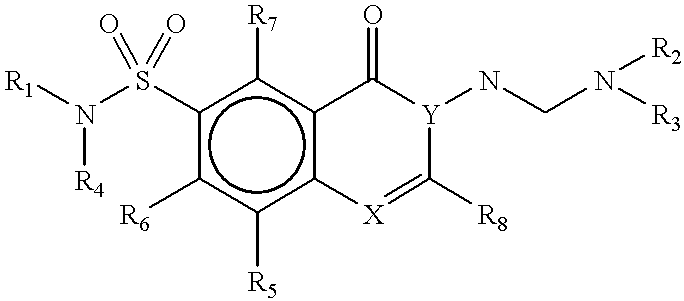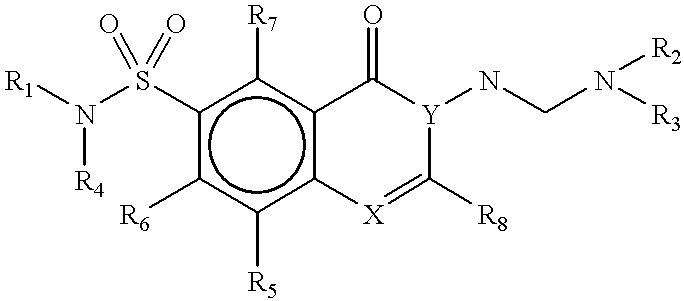Methods for identifying compounds that bind to HLA molecules and use of such compounds as HLA-agonists or antagonists
a technology of hla and molecule, applied in the direction of instruments, drug compositions, immunological disorders, etc., can solve the problems of instability attributable to proteinase degradation, both approaches are less than optimal, etc., to enhance the accuracy of the predicted binding energy of the complex, the effect of a large number of complex structures and greater flexibility in changing
- Summary
- Abstract
- Description
- Claims
- Application Information
AI Technical Summary
Benefits of technology
Problems solved by technology
Method used
Image
Examples
example 2
[0129] In Vitro Testing of the 106 Compounds
[0130] Material and Methods
[0131] The following materials and methods were used for assessing in vitro toxicity, and HLA binding by compounds identified by the described methods.
Cell Lines
[0132] The murine T-cell hybridoma cell line BW58.alpha.-.beta.- (a gift of B. Malissen and W. Born) was used for transfection of human TCR.alpha. and .beta. cDNA isolated from patients with multiple sclerosis (Hastings, 1996). The parental DAP.3 murine fibroblast cell line was used for transfection of DR(.alpha.,.beta.1*1301) or DR((.alpha.,.beta.*1501) as previously described (a gift of C. Hurley and R. Rosen-Bronson)) ([Hurley, 1995), [Posch, 1995), [Rosen-Bronson, 1991). All cells lines were maintained in DMEM supplemented with 10% fetal calf serum, 50 U / ml penicillin G, 50 .mu.g / ml streptomycin, 1 mM sodium pyruvate, 2 mM glutamine, and 10 mM HEPES buffer (all Gibco / BRL, Gaithersburg, Md.). TCR- and HLA-transfectants were expanded using 1 mg / ml G418 ...
example 3
[0137] The activity of compounds identified by MCDOCK in functional assays that measure inhibition of IL-2 secretion by DR1301 and DR1501-restricted TCR transfectants using compound #105 and several other compounds was evaluated. The results obtained with compound #105 are contained in FIG. 3. In the figure t1 and t2 represent dose-response curves generated in two different experiments. TCR and DR transfectants were incubated for 36 hours with or without compound and the appropriate MBP peptide. IL-2 concentration of the supernatants was then analyzed by ELISA.
[0138] Of the compounds screened, compound #105 was the most effective in discriminating between DR-1301 (strong inhibition) and DR-1501 (weaker inhibition) in IL-2 secretion assays.
[0139] FIG. 4 also contains the predicted binding structure of the tested compound to DR1301 produced according to the MCDOCK program.
example 4
[0140] The specificity of the blocking compounds was tested by reversing their inhibitory effects with increasing concentrations of MBP peptide. In this example, the effect of increasing MBP 152-165 peptide concentrations on IL-2 secretion by DR1301-restricted TCR transfectants was evaluated for four compounds, including compound #105. MBP concentrations were varied from 0 to 1200 micrograms / ml.
[0141] Compound #105, exhibited the best dose-response curves when IL-2 production was tested in the presence of increasing MBP peptide concentration. By contrast, reversal of another tested compound induced inhibition of IL-2 production by increasing concentrations of MBP but did not follow a good dose-response curve, suggesting that inhibition of IL-2 secretion was not attributable to specific blocking.
[0142] Also, the effect of lead compound #105 on IL-2 secretion in HLA-1301 and 1501 transfectants is contained in FIG. 9. These results further substantiate the significant effect of this pa...
PUM
| Property | Measurement | Unit |
|---|---|---|
| temperature | aaaaa | aaaaa |
| concentrations | aaaaa | aaaaa |
| three-dimensional structures | aaaaa | aaaaa |
Abstract
Description
Claims
Application Information
 Login to View More
Login to View More - R&D
- Intellectual Property
- Life Sciences
- Materials
- Tech Scout
- Unparalleled Data Quality
- Higher Quality Content
- 60% Fewer Hallucinations
Browse by: Latest US Patents, China's latest patents, Technical Efficacy Thesaurus, Application Domain, Technology Topic, Popular Technical Reports.
© 2025 PatSnap. All rights reserved.Legal|Privacy policy|Modern Slavery Act Transparency Statement|Sitemap|About US| Contact US: help@patsnap.com



